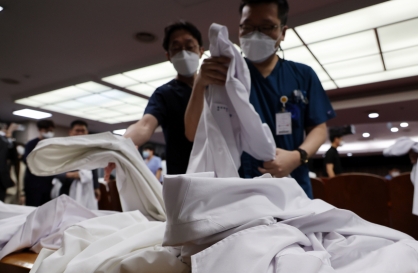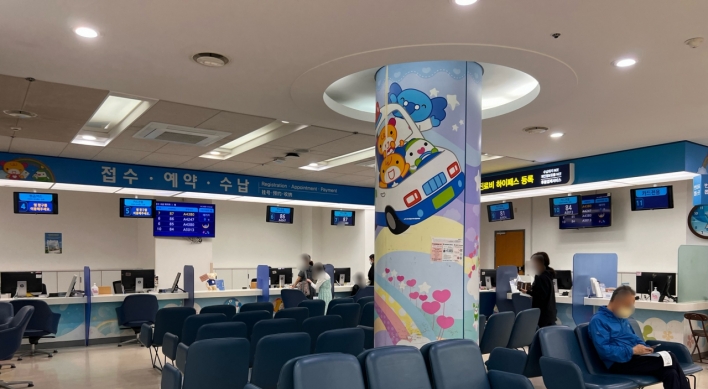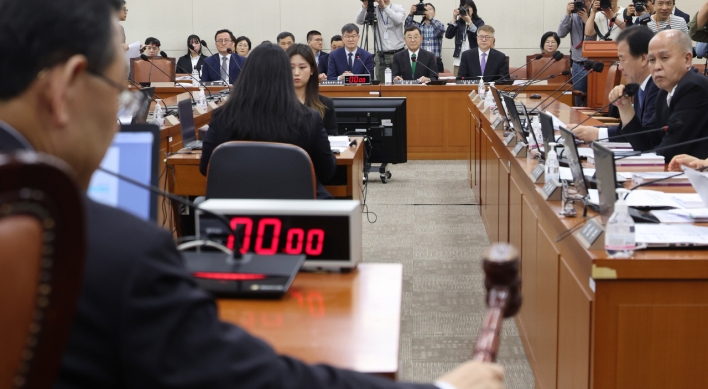
Through a labyrinth of hallways deep inside a 1950s-era building that has housed research that dates back to the origins of U.S. space travel, a group of scientists in white coats is stirring, mixing, measuring, brushing and, most important, tasting the end result of their cooking.
Their mission: Build a menu for a planned journey to Mars in the 2030s.
The menu must sustain a group of six to eight astronauts, keep them healthy and happy and offer a broad array of food. That's no simple feat considering it will likely take six months to get to the Red Planet, astronauts will have to stay there 18 months and then it will take another six months to return to Earth. Imagine having to shop for a family's three-year supply of groceries all at once and having enough meals planned in advance for that length of time.
``Mars is different just because it's so far away,'' said Maya Cooper, senior research scientist with Lockheed Martin who is leading the efforts to build the menu. ``We don't have the option to send a vehicle every six months and send more food as we do for International Space Station.''
Astronauts who travel to the space station have a wide variety of food available to them, some 100 or so different options, in fact. But it is all pre-prepared and freeze-dried with a shelf life of at least two years. And while astronauts make up a panel that tastes the food and gives it a final OK on Earth before it blasts off, the lack of gravity means smell _ and taste _ is impaired. So the food is bland.
On Mars though, there is a little gravity, allowing NASA to consider significant changes to the current space menu. That's where Cooper's team comes in. Travel to Mars opens the possibility that astronauts can do things like chop vegetables and do a little cooking of their own. Even though pressure levels are different than on Earth, scientists think it will be possible to boil water with a pressure cooker too.
One option Cooper and her staff are considering is having the astronauts care for a ``Martian greenhouse.'' They would have a variety of fruits and vegetables _ from carrots to bell peppers _ in a hydroponic solution, meaning they would be planted in mineral-laced water instead of soil. The astronauts would care for their garden and then use those ingredients, combined with others, such as nuts and spices brought from Earth, to prepare their meals.
``That menu is favorable because it allows the astronauts to actually have live plants that are growing, you have optimum nutrient delivery with fresh fruits and vegetables, and it actually allows them to have freedom of choice when they're actually cooking the menus because the food isn't already pre-prepared into a particular recipe,'' Cooper said.
The top priority is to ensure that the astronauts get the proper amount of nutrients, calories and minerals to maintain their physical health and performance for the life of the mission, Cooper said.
The menu must also ensure the psychological health of the astronauts, Cooper explained, noting studies have shown that eating certain foods _ such as meatloaf and mashed potatoes or turkey on Thanksgiving _ improve people's mood and give them satisfaction. That ``link to home'' will be key to astronauts on the Mars mission, and there are currently two academic studies looking further into the connection between mood and food. Lacking certain vitamins or minerals can also harm the brain, she said. (AP)
<관련 한글 기사>
화성에서도 따끈한 피자 먹는다
NASA, 우주인들이 조리해 먹을 메뉴 개발 중
우주여행을 위한 연구가 진행 중인 건물 안 한편에서 흰 가운을 입은 과학자들이 재료를 젓고, 섞고, 분량을 재고, 솔질하고, 맛보며 요리 개발에 열중하고 있다.
이들에게 주어진 임무는 2030년 화성여행을 위한 신 메뉴 만들기.
이들이 개발하는 신 메뉴는 화성탐사에 참여할 우주비행사 6~8명의 건강과 기분을 좋게 유지해줘야 한다. 메뉴의 종류도 다양하게 마련돼야 한다.
게다가 화성까지 가는 데 6개월, 화성에서 머무는 기간 18개월, 다시 돌아오는 데 6개월이 걸리는 것을 감안하면 메뉴를 개발하는 일은 간단치 않은 작업이다.
록히드마틴의 상임연구원인 마야 쿠퍼는 이 어려운 작업을 이끌고 있다.
마야 쿠퍼는 "화성은 너무 멀어서 국제우주정거장에 하는 것처럼 6개월마다 음식을 보내줄 수 없다"고 말했다.
우주비행사들에게는 사실 다양한 음식이 제공되어 왔지만 전부 유통기한이 2년인 냉동건조식품이었다.
NASA는 화성에 약간의 중력 있다는 점에 착안해 화성의 우주비행사들이 미리 조리된 음식이 아니라 현장에서 직접 만든 요리를 먹도록 하는 방안을 연구하고 있다.
과학자들은 화성의 기압이 지구와 다르지만, 압력솥을 이용해 물을 끓이는 것도 가능할 것으로 보고 있다.
쿠퍼의 연구팀은 구체적인 방법으로 '수중 재배법'을 제시했다.
우주비행사들이 흙 대신 무기질이 첨가된 물속에서 채소와 과일을 길러내 지구에서 가져온 향신료와 견과류와 함께 요리를 하는 것이다.
쿠퍼의 연구팀은 벌써 100가지 조리법을 개발했다.
신 메뉴 중에는 치즈 없이 당근, 고추, 버섯, 양파, 땅콩과 매콤한 소스가 가미된 태국식 피자도 있다.
유제품이나 육가공품은 화성에 가져갈 만큼 오래 보관할 수 없어 조리법은 모두 채식으로 마련됐다.
연구진은 단백질도 충분히 공급하기 위해 두부와 견과류를 재료로 사용하도록 했다.
쿠퍼의 연구팀은 조리법 개발에 얼마나 오랜 시간이 걸릴지 확실치 않아 기존의 우주 음식과 비슷한 포장 메뉴도 대안으로 준비하고 있다.
그러나 현재 개발된 포장 음식의 유통기한이 2년이기 때문에 이를 5년까지 늘려 야 하는 과제가 남아있다.
가장 이상적인 방안은 두 가지 개발을 병행하는 것이다.
하지만 연구팀 앞에는 '예산 제약'이라는 큰 장벽이 놓여 있다.
정부의 예산 삭감으로 미국과 유럽이 공동으로 준비하던 2016년 화성 로봇탐사가 취소됐고, NASA의 나머지 예산도 삭감됐다.
NASA의 음식기술개발 프로젝트 연구원인 미셸 페르초노크는 "화성 메뉴를 개발하는 데 연간 들어가는 비용은 평균 100만달러 수준이며 NASA의 2012년 전체 예산은 170억달러 이상"이라며 "화성 탐사가 10~15년 앞으로 다가온 만큼 더 면밀하고 결정 적인 연구를 할 수 있도록 예산이 늘어나길 바란다"고 말했다.




![[Grace Kao] Hybe vs. Ador: Inspiration, imitation and plagiarism](http://res.heraldm.com/phpwas/restmb_idxmake.php?idx=644&simg=/content/image/2024/04/28/20240428050220_0.jpg&u=)

![[Herald Interview] Mom’s Touch seeks to replicate success in Japan](http://res.heraldm.com/phpwas/restmb_idxmake.php?idx=644&simg=/content/image/2024/04/29/20240429050568_0.jpg&u=)


![[News Focus] Lee tells Yoon that he has governed without political dialogue](http://res.heraldm.com/phpwas/restmb_idxmake.php?idx=644&simg=/content/image/2024/04/29/20240429050696_0.jpg&u=20240429210658)








![[Today’s K-pop] Seventeen sets sales record with best-of album](http://res.heraldm.com/phpwas/restmb_idxmake.php?idx=642&simg=/content/image/2024/04/30/20240430050818_0.jpg&u=)